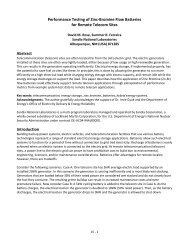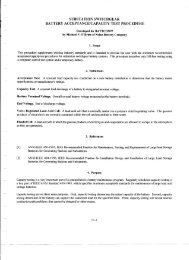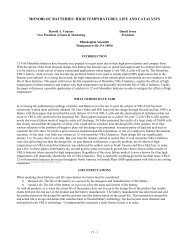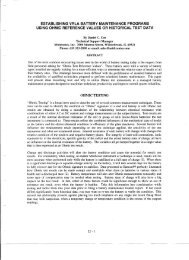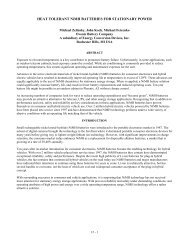Paper - Battcon International Battery Conference
Paper - Battcon International Battery Conference
Paper - Battcon International Battery Conference
You also want an ePaper? Increase the reach of your titles
YUMPU automatically turns print PDFs into web optimized ePapers that Google loves.
A COMPREHENSIVE MANAGEMENT APPROACH TO<br />
MAXIMIZING UPS AVAILABILITY<br />
Gregory W. Ratcliff<br />
Business Development<br />
Emerson Network Power<br />
Westerville, Ohio 43082<br />
INTRODUCTION<br />
For many years lead-acid batteries have been utilized in Uninterruptible Power Supply (UPS) duty, and as of today their reign<br />
does not appear to be ending. This paper explores (primarily) Valve Regulated Lead Acid (VRLA) batteries and strategies to<br />
increase their availability in this environment, but the techniques described are equally effective for larger Vented Lead Acid<br />
(VLA) batteries also. VRLA batteries are particularly well understood and their capacity degradation over time in controlled<br />
conditions has been explored and well documented (Kiel, Sauer, & Turpin, 2008).<br />
Numerous technical advances have enabled directly measuring key indicative values from battery systems continuously and<br />
reliably (2, 14)These permanently installed solutions as stationary instruments are an essential building block to developing a<br />
formalized process whose primary goal was to maximize availability and the service life of UPS service VRLA batteries. All<br />
stationary instrumentation systems produce prodigious amounts of data, provide alarms for rapidly changing events, capture<br />
real time voltage levels during a discharge event and enable routine repeatable testing data.<br />
This paper describes the core elements supporting a comprehensive process that leverages the full capabilities of these<br />
technological solutions, while preventing information overload of the end user and enabling remote analysts to efficiently<br />
manage the state of health of a large number of battery jars simultaneously.<br />
STATIONARY INSTRUMENTS<br />
Permanently-installed resistance, impedance and conductance measuring systems have continued to gain market acceptance,<br />
particularly over the last five years. This paper does not seek to dissuade the reader from an instrumentation approach, but<br />
that stationary instruments are a key element of the described process. Although battery voltage-type monitors may be<br />
installed for alarming, these systems do not provide an indication of battery health (9). These alarming systems were not<br />
considered suitable for increasing availability, while resistance and conductance methods do provide battery state of health<br />
data. Permanently installed battery management systems utilizing resistance or conductance metering have become a more<br />
popular supporting system, particularly in 30KVA and larger UPS systems.<br />
One example for a moderately sized UPS configuration would be comprised of approximately 40 Jars of 12 Volt mono-block<br />
VRLA batteries in series, with each jar containing 6 cells. This class of UPS supporting configuration demands high<br />
discharge rate performance of 240 cells for every “UPS On-<strong>Battery</strong>” event. Due to the use of 12 Volt jars in this<br />
configuration, “metering points” only exist for one sixth of the cells. Consider that for such a large number of cells, coupled<br />
with the ability to only externally observe, the measurement task becomes more difficult.<br />
For example, assume that one cell of a 12 Volt mono-block begins to fail and THAT cell’s resistance increases by 10%. The<br />
overall resistance as observed for that jar will only increase by 1.6%, presuming a worst case scenario of all other cells being<br />
completely normal and healthy.<br />
Therefore, these high jar count and high cell count configurations demand the highest possible repeatability in<br />
instrumentation for resistance and conductance. Shown below is a sampling of instruments available to the marketplace. Note<br />
that resolution and accuracy for Stationary Systems are typically better than Portable Systems. Although not explored here, it<br />
could be argued that repeatability is more important than initial accuracy; repeatability is not a value that is easily represented<br />
in product specifications. In support of this effort and process development the ambient temperatures are always recorded, as<br />
are the negative post temperatures of all jars. If the environmental conditions have changed significantly, then the<br />
repeatability of the stationary instrument is considered part of the base errors.<br />
15 - 1
Figure 1 Instrument Accuracy<br />
Vendor Range Accuracy Resolution<br />
Portable Vendor 1 100-19,990 Siemens +2% across test range 5 mV<br />
Portable Vendor 2 0-xx µOhms +/ 75 µOhms 6 mV<br />
Stationary Vendor 3 0-32,000 µOhms +/- 5 µOhms 4 mV<br />
More than one third of the root cause evaluations of “UPS down units” is a direct result of battery failure (6). Several other<br />
factors have caused a change in the needs of Data Center customers that demand these systems.<br />
First and foremost, the DC bus voltages of UPS systems in the range of 20KVA to 500KVA (6) are between 400 and 575<br />
VDC. With more than 2000 injuries from Arc-Flash and 97% of technicians being shocked on the job in 2010, increasing<br />
worker safety continues to be a top priority in the electrical service industry and is mandated federally (CFR, 2010). Every<br />
worker exposed to these medium voltage DC systems represents personnel risks and vulnerability to the system itself (3). The<br />
time and costs to manually measure key performance values, like resistance, has become impractical more than a few times<br />
per year. Not unexpectedly, for UPS maintenance, many enterprises have switched to utilizing external experts, skilled,<br />
trained and equipped for manually servicing medium voltage battery strings.<br />
*Certified Engineer (CE)<br />
Figure 2 (8) Induced Outages<br />
Another primary shift to stationary instruments has been caused by the enhanced repeatability of permanently installed<br />
instruments (14). The basic construct and philosophy of stationary instrumentation systems is based upon establishing an<br />
initial baseline value, particularly for resistance or conductance. This baseline is then examined repeatedly at regular<br />
intervals, ranging from once a week to one time a month. Portable instruments are certainly capable of repeatable, reliable<br />
readings; but several elements of potential error are eliminated with a stationary system, namely: instrument calibration,<br />
measurement points, connections, and lead variation errors.<br />
Stationary instruments are capable of storing data internally and are “on the job” continuously to capture alarms, events and<br />
measure the batteries during a discharge, eliminating the requirement to install a separate voltage alarm system. This database<br />
is available during forensic analysis and performance analysis. However, key to maintaining availability is the long term and<br />
continuous storage of data trends of the resistance or conductance of the battery jars (by jar). Storing and graphically<br />
presenting data concerning the comprehensive state of operation and state of health of the battery strings are the primary<br />
value offerings provided to the UPS operator.<br />
OPERATORS<br />
Much has been written concerning the centralization and consolidation of data centers (13). A consolidation of expertise has<br />
occurred also. Personally participating in many battery service events during late 2010, my observation is that the operators<br />
have a great many additional responsibilities and the battery subsystem and its welfare is often entirely managed by their<br />
trusted service providers. While some data centers are experiencing runaway growth, others are being impacted by economic<br />
conditions, often postponing critical infrastructure service (like UPS batteries). These operators demand both immediate<br />
notifications of events and access to state of health data in partnership with their service provider, and desire higher level<br />
summaries, with more supporting data. The day may have passed where on the recommendation of a service provider a<br />
battery string is replaced.<br />
15 - 2
SERVICE PARTNERS<br />
The classic role for a service partner has been to safely provide preventive maintenance inspections and measurements in<br />
person to the battery system. From visual inspections, to torque measurements, to hydrometer readings, an expert visited the<br />
batteries and deemed them healthy or they have pointed out any observed deficiencies directly to the operator. Interpreting<br />
these deficiencies was handled between the service partner and the operator. In most cases the service partner’s role does not<br />
extend to utilizing stationary data on site, the stationary instrument or confirming its calibration.<br />
PM Safety Factor and<br />
Error Rate<br />
Figure 3 (8)<br />
Number of PMs at Which MTBF Peaks According<br />
to PM Safety Factor<br />
0.98000 or 2% or 1/50<br />
0.99000 or 1% or 1/100<br />
0.99500 or 0.5% or 1/200<br />
0.99998 or 0.002% or 1/5000<br />
Technology solutions may never negate the need for frequent, in person examination of battery systems. Today these systems<br />
serve to improve the capabilities of the service technician. Often these systems point directly to a jar that upon further<br />
inspection has an issue or impending failure. Remembering that Mean Time Between Failures (MTBF) is the statistical<br />
likelihood of a failure (see Figure 4). An extensive analysis of 185 million operating hours conducted for medium voltage<br />
UPS use indicates that MTBF increases by a factor of 10 for a single annual visit, by 51 times for quarterly preventive<br />
maintenance and 82 times for 8 week preventative maintenance, see Figure 5. (3), over break-fix service paradigms.<br />
Figure 4 (8)<br />
15 - 3<br />
1<br />
1<br />
2<br />
19<br />
0 2 4 6 8 10 12 14 16 18 20 22<br />
Number of Preventive Mintenance Visits
Times Better<br />
100<br />
80<br />
60<br />
40<br />
20<br />
0<br />
Figure 5 (8) Increase In MTBF<br />
Increase in MTBF When Compared to No<br />
Preventive Maintenance<br />
0<br />
10<br />
23<br />
TRANSPORTING DATA<br />
The increase in sheer volume of produced data and base alarm levels produced has demanded that network transports be<br />
utilized for all battery telemetry, alarms, real-time events and stationary instrument testing. There are several methods utilized<br />
today, with reverse VPN being the most secure and protocol neutral methodology (12), for Ethernet transportation.<br />
Service partners that require remote access to an enterprise system behind firewalls will occasionally implement either a<br />
hardware or software Virtual Private Network (VPN) connection from the enterprise to the service partner’s network. These<br />
dedicated connections, known as site to site VPN connections, require IT resources of both organizations to set up and<br />
establish fixed endpoints on the internet to create an information tunnel between the businesses. Often the enterprise limits<br />
the direct connection permissions in an IP address “white list”, the list of addresses that the service partner can address.<br />
Software based permanent VPNs operate identically, but are established in router and server hardware directly. Several<br />
tutorials exist which indicate this dedicated usage methodology (11).<br />
Other Enterprises will allow their Service Partners to install their VPN client software on the Partner’s computers to gain<br />
access to the network and therefore the devices. These are known as remote access VPNs (5). This connectivity keeps access<br />
control directly in the Enterprise’s hands, but requires individual accounts for each remote user. The resultant chaos for the<br />
service partner includes many logins and passwords for the enterprises they serve.<br />
Furthermore, no Machine to Machine (M2M) connectivity exists, requiring manual interaction with the remote system.<br />
Hybrid systems have been developed that push data out over conventional methods. These hybrid approaches range from<br />
email to web-based systems. These are effective output only systems and tend to be dedicated purpose constructs. Relying on<br />
email to transport alarm telemetry places the enterprise at the vulnerability of an often over used resource in both businesses.<br />
An effective data transport methodology is an automated dynamic VPN based system. These systems create an on-demand<br />
M2M connection from the remote system for alarms, system events and routine data transport. These secure, encrypted<br />
methods utilize well accepted Secure Socket Layer (SSL) connections that have been employed throughout the internet for<br />
secure consumer transactions with web sites. One example dynamic VPN solution is detailed below. These operate much like<br />
a software VPN installed on many laptops. A dynamic VPN allows for scalability, but also allows both the enterprise and the<br />
service partner to transparently manage access for the two businesses, not one device to one person (7).<br />
15 - 4<br />
37<br />
0 1 2 3 4 5 6<br />
51<br />
67<br />
Number of Annual Preventive Maintence Visits<br />
82
Figure 6 A Common Dynamic VPN Architecture<br />
ENABLING REMOTE ANALYSIS<br />
These Technical innovations that have enabled wholesale data transmission have enabled an additional role, namely the<br />
analysis engineer. In this role the entire historical lifespan of the battery jar is analyzed and compared both against its nearby<br />
family and its extended family (the entire portfolio for that battery model) over time. The graphical presentation and portfolio<br />
data afforded to these specialized engineers allows extensive leverage of their skills. For example, one analyst can patrol 500-<br />
1000 battery strings. In examining a “day in the life” of an analyst I have found that for any particular day the analyst takes<br />
an overview examination of 20-40 battery strings consisting of 40-240 Jars, with VRLA type jars demanding the most<br />
attention. From these overview analyses, an in depth look is taken at one or two strings resulting in a final analyst’s<br />
recommendation. This recommendation is conducted in consultation with the field engineering staff directly, resulting in a<br />
final state of health determination for the jar and string.<br />
RESULTS<br />
This unique three party relationship between the operator, field engineer and analysis engineer has resulted in absolute<br />
uptime and availability for UPS battery strings since 2006, with hundreds of millions of hours of runtime. There are several<br />
key elements of this business intelligence based approach that resulted in such high availability.<br />
First, the economic defense of properly maintaining a particular string is immediately rewarded through frequent and<br />
repeatable testing with jars that need additional examination. When a failing battery jar is detected (pre or post warranty), a<br />
detailed history of received telemetry is available, including the three key elements of temperature, voltage and resistance<br />
over the lifecycle of a particular battery jar. Rogues are detected accurately and early.<br />
The “defense” and evidentiary case to expeditiously remove a defective jar is easily made; the data virtually eliminates any<br />
“wait and see” dialog with the operator’s finance department.<br />
Second, the supporting on-site maintenance keeps watch over the slow moving and less detectable issues that can occur<br />
occasionally. For example, a leaking post seal will ultimately be detected by the stationary instrument as high resistance due<br />
to dry out, but an on-site inspection will observe this long before sufficient electrolyte loss has affected resistance. Again, a<br />
well defended case of a physical observation that is not disputable removes any questions as to the correct course of action.<br />
Finally, the detailed voltage events are recorded and displayed to the operator upon demand. Seeing how the battery string<br />
has actually performed during a discharge event absolutely and conclusively confirms the energy delivery from each and<br />
every jar in every string of the battery system.<br />
Tying these three elements together in both local graphical real-time and graphical report formats for the operator and field<br />
engineer allow more rapid detection and ultimately drives corrective action based decision making to quickly replace<br />
defective jars from battery strings.<br />
15 - 5
CONCLUSION<br />
There will always be a grey area between perfectly suitable and barely suitable battery performance. Technological advances<br />
in recent years have greatly reduced the relative width of this grey area. Advances in processes and methodology have<br />
demonstrably decreased it further. Figure 7 below, details that the top two uses for remote telemetry by best in class<br />
businesses are condition and performance (1). Coupled with on-site experts the availability increases have allowed battery<br />
availability to be increased dramatically. The resultant benefit has been increased availability and ultimately real dollar<br />
savings in operational uptime for critical facilities operators. As the technical solutions have been delivered to operators, the<br />
ability to add additional, remote expertise that is greatly leveraged by the technology allows a breakthrough in service<br />
capabilities that were previously out of reach for all but the largest enterprises.<br />
Figure 7 Remote Connectivity Uses<br />
15 - 6
WORKS CITED<br />
1. Aberdeen Group. (2010). Use of Remote Connectivity. Boston: Aberdeen Group.<br />
2. Albér, G. (2003, January 2). OHMIC MEASUREMENTS: THE HISTORY AND THE FACTS. Retrieved March 1,<br />
2011, from Albér: http://www.alber.com/Docs/Alber<strong>Paper</strong>FINAL2003.pdf<br />
3. Buildings Magazine. (2008, 03 1). Preventive Maintenance is Vital to Data Center Health. Buildings , p. 5761.<br />
4. CFR, O. (2010, 1 1). OSHA. CFR29 Parts 1910.137, 1910.302, 1910.303, 1910.304, 1910.305, 1910.306, 1910.307,<br />
1910.308, 1910.331, 1910.332-1910.335. Washington D.C., Washington D.C., USA: FPO.<br />
5. Cisco. (2008, February 20). Remote-Access VPNs: Business Productivity. Retrieved March 1, 2011, from Cisco.<br />
Com:<br />
http://www.cisco.com/en/US/prod/collateral/vpndevc/ps6032/ps6094/ps6120/prod_white_paper0900aecd804fb79a.p<br />
df<br />
6. Donato, J. (2011, January 1). Real-Tim, Remote Monitoring Key to Optimal <strong>Battery</strong> Performance. <strong>Battery</strong> Power ,<br />
pp. 8-9.<br />
7. Emerson Network Power. (2006, January 15). Secure Remote Monitoring of the Critical Infrastructure. Retrieved<br />
March 3, 2011, from Emerson.com: http://www.emersonnetworkpower.com/en-<br />
US/Brands/Liebert/Pages/LiebertGatingForm.aspx?gateID=297<br />
8. Emerson Network Power. (2007, November). The Effect of Regular, Skilled Preventive Maintenance on Critical<br />
Power System Reliability. Retrieved March 3, 2011 from Liebert.com:<br />
http://www.liebert.com/common/ViewDocument.aspx?id=852<br />
9. Furlong, T. (2000). Yes...Internal Cell Resistance Measurements Are Valid. <strong>Battcon</strong> Proceedings (pp. 3-1). Boca<br />
Raton: Albércorp.<br />
10. Kiel, M., Sauer, D., & Turpin, P. (2008). Extensive Validation of a Nonintrusive Continuous <strong>Battery</strong> Monitoring<br />
Device. <strong>Battcon</strong> (pp. 18-1). Marco Island: Albércorp.<br />
11. Microsoft, S. (2003, 12 1). Virtual Private Networking with Windows 2003. Retrieved 3 15, 2011, from Microsoft<br />
TechNet: http://technet.microsoft.com/en-us/library/bb727041.aspx<br />
12. Neil, S. (2008, April 8). ComBrio Offers Secure Way to Remote Access Industrial Ethernet Networks. Managing<br />
Automation , p. 31915.<br />
13. Reed, B. (2009, October 13). Data Center consolidation runs rampant. Network World , p. 101.<br />
14. Stukenberg, T., & Dwyer, T. (2003). Using Conductance Technology To Ensure <strong>Battery</strong> System Reliability. <strong>Battcon</strong><br />
<strong>Conference</strong> Proceedings. AlbérCorp.<br />
15 - 7





